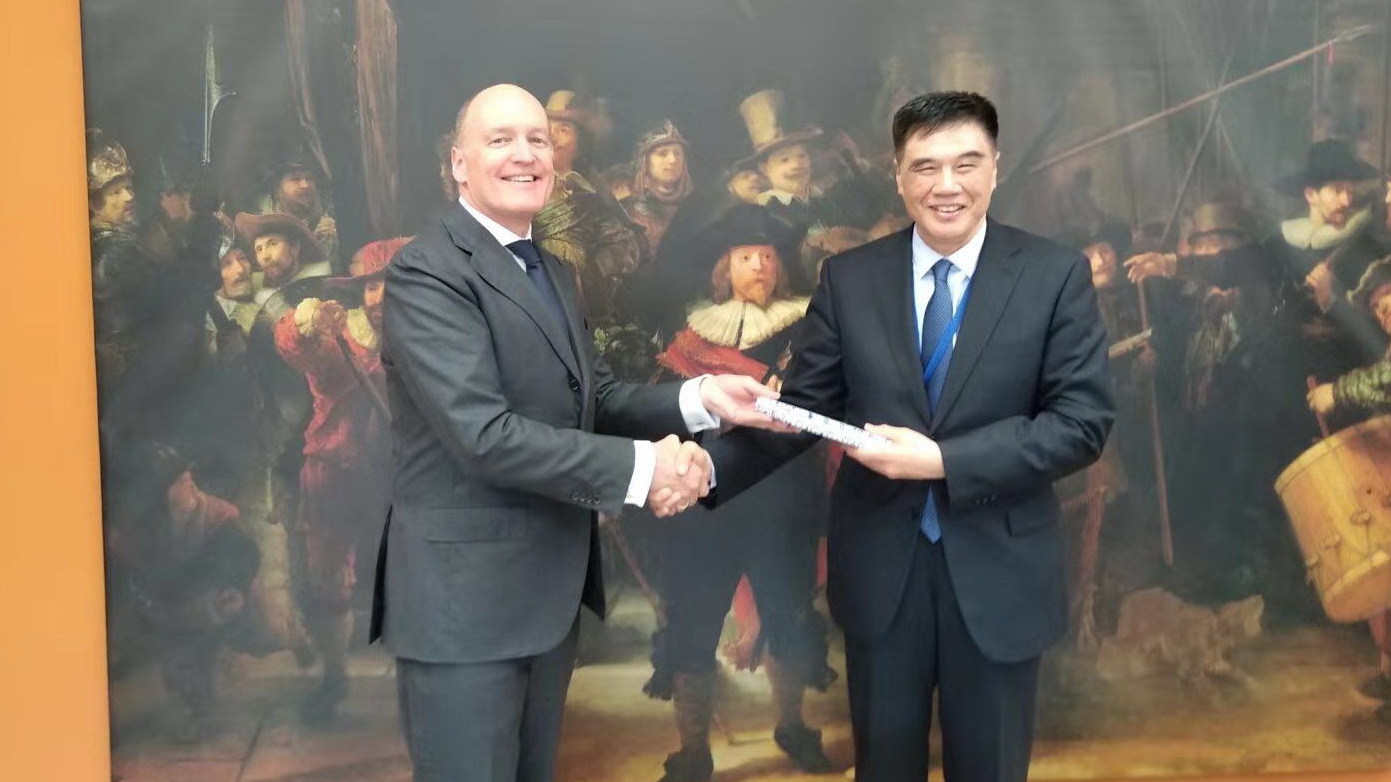CCIEE Vice Chairman Zhang Xiaoqiang Meets with Wim Geerts, the Dutch Ambassador to China
- Time:2021-03-04
- source:CCIEE
On February 24, 2021, CCIEE Vice Chairman Zhang Xiaoqiang was invited to meet with the Dutch ambassador to China, Wim Geerts at the Dutch Embassy. The two sides had in-depth exchanges on China’s economic development, the world economy, and China-EU and China-Dutch economic and trade cooperation. Zhang Huanbo, head of the US-Europe Institute at CCIEE, Yuan Youwei, Secretary of the New Economy Forum and Deputy Director of Department of External Affairs at CCIEE, and Jan-Emile van Rossum, Head of the Economics Department and Economic Counsellor of the Dutch Embassy were also present at the meeting.

Ambassador Wim Geerts extended a warm welcome to Zhang Xiaoqiang and his colleagues, affirmed China’s achievements in poverty alleviation and positive economic growth in 2020, and expressed concern about China’s future development and the “14th Five-Year Plan”. He said that cooperation in various fields can be Strengthened in the future between the two sides.
Zhang Xiaoqiang pointed out that the Fifth Plenary Session of the 19th Central Committee put forward the long-term goal of China’s basic realization of socialist modernization by 2035, and proposed speeding up the construction of the new development pattern of dual circulation. As the world’s largest trading country, China’s trade accounted for up to 14% of the world’s total in 2020. In the face of increasingly fierce international competition and protectionism, China will pay more attention to the domestic market, adhere to supply-side structural reform, strengthen demand-side management, reduce the gap between coastal and inland areas, take more effective measures to coordinate urban and rural development, and adjust urban-rural income distribution. China will continue to implement the basic national policy of opening-up. In 2020, China further expanded its opening-up, such as lowering the market entry threshold in the financial sector. In the future, it will further enlarge the opening-up in various fields, deepen the reform, optimize the business environment, strengthen the compliance with international rules, and promote international trade and investment cooperation. In the next five years, China will pay more attention to high-quality development and its average annual economic growth rate will be 5%-5.5%.
Despite the impact of the COVID-19 pandemic, Zhang Xiaoqiang believes that the economic and trade cooperation between China and the EU will remain strong. According to China Customs, the bilateral trade volume between China and the EU reached US$650 billion in 2020, an increase of about 5% year-on-year. The data of Eurostat also shows that China has become the largest trading partner of the EU. In 2020, the China-Europe freight train reached 12,406 trains, a year-on-year increase of 50%, which stabilized the industrial chain and supply chain. At the end of 2020, the negotiations on the China-EU Investment Agreement were also concluded. China and the EU have extensive common interests and thus, the two sides should adopt a more open attitude, strengthen cooperation, expand investment and trade, adhere to multilateralism, and safeguard the multilateral trading system based on the WTO. Furthermore, they should work together to address common global challenges, strengthen cooperation in areas such as climate change, digital economic development, public health and macroeconomic cooperation.
Zhang Xiaoqiang pointed out that the problem of chip shortage is not only affected by decoupling factors, but also caused by the COVID-19 pandemic. All parties should strengthen cooperation at the technical and political levels, rather than confrontation. The US National Chamber of Commerce proposes that the US government should distinguish between military and civilian use of semiconductors. It should be noted that chips are widely used in China’s civilian field and the market potential is huge. In 2020, China imported 350 billion US dollars of chips, an increase of 14.6%. Moreover, China’s domestic chip production also achieved a 16% growth.
Zhang Xiaoqiang said that the pandemic has stimulated the growth of personal computers and the health sector in China. For example, the sales of tablets and notebooks achieved a 15% growth in 2020. China will enter an aging society and the demand for elderly care will increase accordingly, implying that China and Europe could also strengthen cooperation in the fields of medical supplies and vaccine research and development. In the past few years, the US-China relations faced serious challenges and hopefully, President Biden will make a difference after taking the office.
Ambassador Wim Geerts said that both the Netherlands and China embrace pragmatic cooperation and have a solid foundation for cooperation. In 2014, President Xi Jinping visited the Netherlands and the Dutch-Chinese relations have developed rapidly and healthily. In 2020, the bilateral trade between the two countries grew steadily. as the second-largest agricultural exporter in the world, the agricultural industry plays a very important role in the Dutch economy. The Netherlands and China have huge potential for cooperation in agriculture. We must continue to deepen the economic and trade cooperation while exploring cooperation in third-party markets.
Zhang Xiaoqiang noted that the Netherlands has an important position in the EU foreign trade and cooperation, and some of its ports have always played an important role in the trade between China and the EU. China and the Netherlands can strengthen third-party market cooperation in countries along the “Belt and Road” route.
He also stressed that WTO reform requires us to reform the digital trade field, establish a framework for digital trade to meet the needs of smart cities, e-commerce and online education. and discuss issues such as data flow and the management of giant companies. In terms of differential treatment between developing countries and developed countries, it is necessary to retain special treatment for less developed countries.
